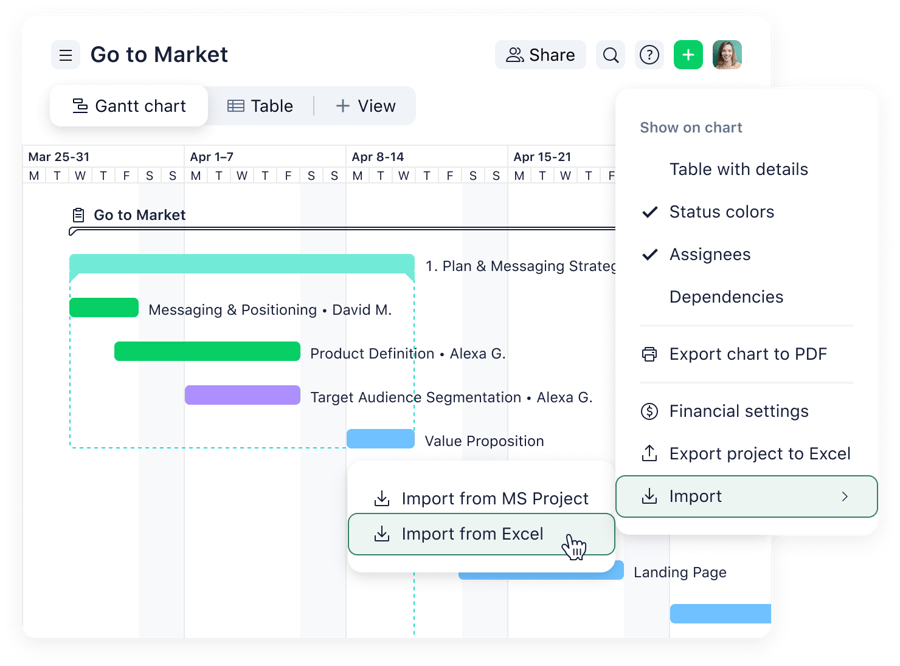Have you ever wondered why some products hit the market with a bang while others fizzle out?
Launching a product can be challenging for businesses. Companies may feel that a broad marketing strategy is all they need. However, launching a product or entering a new geography requires a specialized approach.
No company wants to launch an unprofitable product or go after the wrong audience. That’s why companies should create and launch successful products with an intentional and well-thought-out go-to-market strategy.
Let’s say you want to launch an innovative new app. You need to ask yourself questions like:
- How will people learn about the app?
- How will you convince them to download it?
Templates, like Wrike’s go-to-market strategy template, can be game changers in answering these questions. You can organize your GTM plan by phases, ensuring all components are perfectly aligned for the product release. This helps in accurately tracking ROI and making sure your product launch is as smooth and impactful as possible.
By the end of this article, you’ll see how strong go-to-market strategy examples can make all the difference in getting your product off the ground and into the hands of eager customers. Are you ready to see how it’s done? Let’s go!
Why do you need a go-to-market strategy?
When a startup or corporation brings a product to market, they need a robust strategy. A US Bank research study confirms that 78% of small businesses fail without a planned marketing strategy.
A go-to-market strategy is a step-by-step roadmap that companies use to launch a new product or enter new territory. A marketing project management software can greatly help in the execution of the strategy by assigning specific tasks to each team member, tracking the progress and ensuring the entire campaign is visible across the business to ensure cross-functional alignment.
Remember the much-hyped failure of Google Glass in 2017? It attempted to connect consumers to augmented reality with a smartphone-enabled, head-mounted device. Unfortunately, it was launched without a planned marketing campaign to a market with zero demand.
That is a perfect example of why companies of all sizes need a thoughtful and intentional strategy to take the product to market.
Reasons why a go-to-market strategy is important for your business
A go-to-market strategy contains in-depth market research, lessons from previous company experience, and competitive data from the market. Companies can use this information to:
- Launch a new product in the market
- Expand into a new market with the same product
- Relaunch existing products in the same market
The main reasons for introducing a go-to-market strategy include:
Achieving product launch success
95% of product launches fail every year. From Microsoft's Windows Vista in 2007 to Samsung’s Galaxy Note 7 in 2016, product failures have led to losses of millions and even billions of dollars.
The reasons include poor marketing, wrong product-market fit, or the lack of a planned launch strategy. The presence of an effective go-to-market strategy ensures that the products meet audience needs, create brand awareness in the market, and help companies achieve their business goals.
By using the consumer-first mindset, Apple created cutting-edge technology products that were accessible to the world at large. Its most successful product, the iPhone, was launched in 2007 in a saturated marketplace.
However, it became one of Apple’s best-selling products, catapulting the company to the top of the smartphone market and positioning it as 2022’s most valuable brand.
Thriving in the marketplace
A brand may be successful, but there's no guarantee that it will continue to rule the roost forever. The success continues if they evolve with changing customer needs and constantly innovate to stay ahead of the curve. New rivals can enter the market, and industry regulations and customer needs can change over time.
Something similar happened with Kodak. Launched in 1888, it was the market leader in cameras for nearly a century. However, failure to capitalize on newer market trends and changing consumer needs led to Kodak's downfall and subsequent bankruptcy.
Resonating with customer needs
The primary objective of every growing business is to remain relevant in the marketplace. Using go-to-market strategies can help define the target audience's characteristics and curate the message to be communicated to them.
Dunkin’ Donuts is a prime example. To grow to over 3,200+ stores in 36 countries outside of the U.S., Dunkin’ Donuts adapted to different markets by constantly innovating to meet local tastes while championing its global bestsellers.
What should every go-to-market strategy include?
A go-to-market strategy includes four core components:
- Target market: Which section of the market is perfectly aligned with your products and services? Identify who you want to target and what message you’d like to send out. If you're targeting Gen Z, you will need to keep the content informative, bite-sized, and visual and utilize relevant platforms where they hang out, such as TikTok.
- Product-market fit: Determine if your product has a significant market need. Product-market fit exists when your product helps a niche group of consumers solve their problems. Getting the fit right is key for a successful business.
- Distribution model: Brainstorm the business model you want to set up for your product. One of the major deciding factors when choosing a distribution model is the type of customer you want to target. Discover if they prefer to use a standalone website, social media platform, or mobile application.
- Competition and market demand: Review the market to see if customer needs are being adequately met. Avoid an over-saturated industry or one with very few companies, as that may signal a lack of significant demand. Instead, position your brand by highlighting its unique selling proposition.

Go-to-market strategy types and examples
Since every product or service is unique, each requires a different go-to-market strategy. A go-to-market strategy helps with:
- Identifying a target audience for the product or service
- Designing a specialized marketing plan
- Outlining a planned product sales strategy
- Delivering exceptional customer experiences
Let's dive deeper into the different types of go-to-market strategies that can inspire you to craft one for your business.
Inbound go-to-market strategy
Launching products that align with your customers' demands is a great way to stay relevant in the market.
With an inbound go-to-market strategy, companies create relevant product content that attracts the audience to connect with the business organically. Some examples of inbound content include social media posts, YouTube videos, infographics, or long-form blogs.
Customers discover your brand through your content and messaging and approach you on their own. All the conversations generated become potential leads, whether you’re running a startup or a larger organization.
Canva's Design School is a great example. It is an online space that helps users learn graphic design with simple, guided video tutorials. With well-structured courses, users gain design and branding skills that help them achieve their design goals. Since the content is genuinely helpful, it leads to more sign-ups and greater revenue for Canva.

Sales enablement go-to-market strategy
In a sales enablement go-to-market strategy, the sales team is empowered with specialized training and coaching that speed up sales cycles and increase sales.
This relationship-focused demand generation strategy works great for a go-to-market team that includes frontline sales staff, account representatives, and sales managers.
Provide the resources, tools, and content the salespeople need for buyer engagement to convert them from prospects to loyal customers, such as:
- Competitor research documentation
- Case studies detailing past customer successes
- Informative blog posts
- Onboarding content
- Summarized reference sheets or one-page brochures
Involve sales teams in all your marketing campaigns and ensure they know the product goals and customer journeys. Share customer-centric KPIs and metrics and establish regular feedback loops to keep every activity on track.

ABM go-to-market strategy
Teamwork is a key component of every account-based marketing (ABM) strategy. In this type of go-to-market strategy, marketing and sales teams work together to identify best-fit clients for the business.
Though account-based marketing is primarily used in the business-to-business (B2B) domain, it also works for business-to-consumer (B2C). Teams deliver personalized buyer experiences by tailoring the communication, messaging, and content to the end-buyers.
GumGum, a contextual intelligence and advertising optimization company, utilized a personalized ABM strategy to win one of its largest business deals with T-Mobile. After discovering that the CEO of T-Mobile is a huge Batman fan, they commissioned the 'T-Man and Gums' comics. Gums provided T-Man with the ability to overthrow poor cell phone service in the city.
Apart from generating massive Twitter virality with this hyper-personalized approach, GumGum landed the T-Mobile account.

Demand generation go-to-market strategy
A demand generation go-to-market strategy includes all sales-centric tactics and marketing activities such as cold calling, sponsored webinars, buying lists, email blasts, and television commercials.
It focuses on creating audience demand by generating brand awareness and an immediate buzz around the product launch.
GoPro used this strategy with great success. Instead of reaching out to photographers, they created a targeted social media campaign on Twitter, #HomePro, for people who love telling stories. They used user-generated content to inspire product demand without promoting the core product itself.

How to get started with Wrike's Go-To-Market Template
A clearly defined go-to-market strategy determines how successful a product or service will be in the marketplace. Craft a well-researched and planned marketing strategy to attract the right audience, earn their trust, and achieve your sales targets.
Whether entering a new market or launching a product, Wrike’s free go-to-market strategy template helps align your teams toward your business goals.
Use the template to:
- Break your GTM strategy into tasks and assign them
- See progress with the Board view
- Plan your project and track performance with Gantt charts
- Monitor the entire project with a custom dashboard
Ready to try this template? Start a free Wrike trial to organize your marketing initiatives, enhance project visibility, and successfully take your product to market.





